lecture 2 _ Risk and Return
- 格式:pdf
- 大小:476.96 KB
- 文档页数:34
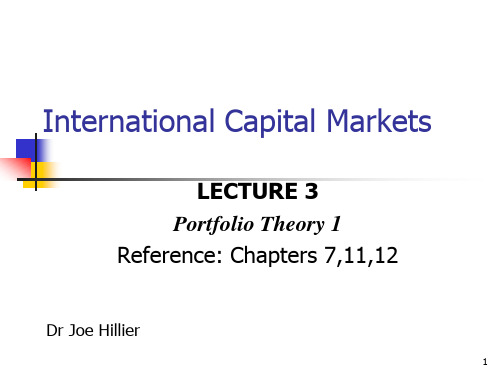
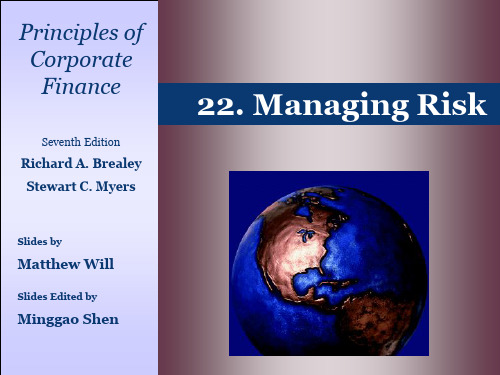

2019年英语专业八级真题听力Mini-lecture(2)1 I also notice another interesting thing about this.关于这一点,我还发现了另一个有趣的现象。
It seems women are much more likely to do this kind of t hing than men.女性似乎比男性更有可能做出这种动作。
I mean women are more likely to make themselves small .我的意思是,女性更有可能让自己变小。
Women feel chronically less powerful than men,so this i s not surprising.女性总感觉自己的力量比男性弱,因此这并不令人惊讶。
The second question concerns our minds.第二个问题是关于我们的意识。
We know that our minds change our bodies.我们知道,我们的意识会改变我们的身体。
But is it also true that our bodies change our minds? 但我们的身体也可以改变我们的意识吗?And when I say minds,in the case of the powerful,what do I mean?当我说到意识的时候,以强大的力量为例,这是什么意思呢?I'm talking about thoughts and feelings and the sort of ph ysiological things that make up ourthoughts and feelings, 我在说想法和感觉,以及组成我们想法和感觉的生理上的东西,and in my case,that's hormones.就这件事而言,是指激素。
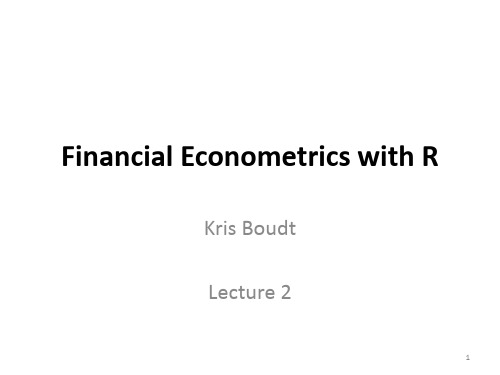
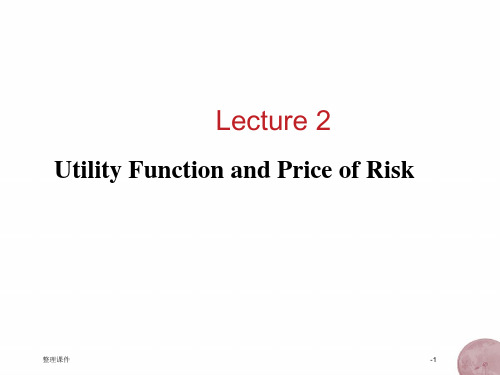
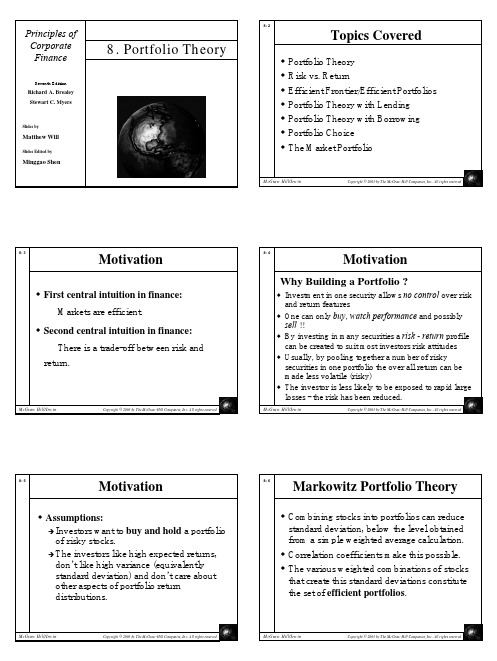
Principles of Corporate FinanceSeventh EditionRichard A. Brealey Stewart C. MyersSlides byMatthew WillSlides Edited byMinggao Shen8.Portfolio Theory8-2McGraw Hill/IrwinCopyright ©2003 by The McGraw-Hill Companies, Inc. All rights reservedTopics CoveredPortfolio TheoryRisk vs. ReturnEfficient Frontier/Efficient Portfolios Portfolio Theory with Lending Portfolio Theory with Borrowing Portfolio Choice The Market Portfolio8-3McGraw Hill/Irwin Copyright ©2003 by The McGraw-Hill Companies, Inc. All rights reserved MotivationFirst central intuition in finance:Markets are efficient.Second central intuition in finance:There is a trade-off between risk and return.8-4McGraw Hill/Irwin Copyright ©2003 by The McGraw-Hill Companies, Inc. All rights reservedMotivationInvestment in one security allows no control over risk and return featuresOne can only buy , watch performance and possibly sell !!By investing in many securities a risk -return profile can be created to suit most investors risk attitudes Usually, by pooling together a number of risky securities in one portfolio the over all return can be made less volatile (risky)The investor is less likely to be exposed to rapid large losses -the risk has been reduced.Why Building a Portfolio ?8-5MotivationAssumptions:ÎInvestors want to buy and hold a portfolio of risky stocks.ÎThe investors like high expected returns, don’t like high variance (equivalently standard deviation) and don’t care about other aspects of portfolio return distributions.8-6Markowitz Portfolio TheoryCombining stocks into portfolios can reduce standard deviation, below the level obtained from a simple weighted average calculation. Correlation coefficients make this possible. The various weighted combinations of stocks that create this standard deviations constitute the set of efficient portfolios .8-7McGraw Hill/IrwinCopyright ©2003 by The McGraw-Hill Companies, Inc. All rights reservedMarkowitz Portfolio TheoryPrice changes vs. Normal distributionMicrosoft -Daily % change 1990-20010.020.040.060.080.10.120.14-9-8-7-6-5-4-3-2-1123456789P r o p o r t i o n o f D a y sDaily % Change8-8McGraw Hill/IrwinCopyright ©2003 by The McGraw-Hill Companies, Inc. All rights reservedMarkowitz Portfolio TheoryStandard Deviation VS. Expected ReturnInvestment A2468101214161820-5050% p r o b a b i l i t y% return8-9McGraw Hill/IrwinCopyright ©2003 by The McGraw-Hill Companies, Inc. All rights reservedMarkowitz Portfolio TheoryStandard Deviation VS. Expected ReturnInvestment B2468101214161820-5050% p r o b a b i l i t y% return8-10McGraw Hill/IrwinCopyright ©2003 by The McGraw-Hill Companies, Inc. All rights reservedMarkowitz Portfolio TheoryStandard Deviation VS. Expected ReturnInvestment C2468101214161820-5050% p r o b a b i l i t y% return8-11Markowitz Portfolio TheoryStandard Deviation VS. Expected ReturnInvestment D2468101214161820-5050% p r o b a b i l i t y8-12Markowitz Portfolio TheoryCoca ColaReebokStandard DeviationExpected Return (%)35% in ReebokExpected Returns and Standard Deviations vary given different weighted combinations of the stocks (An example from last lecture)8-13McGraw Hill/Irwin Copyright ©2003 by The McGraw-Hill Companies, Inc. All rights reservedPortfolio Risk1.Given the level of risk, or standard deviation, we prefer portfolio positions with higher expected ratesof return.2.Given the level of expected return, we prefer portfolio positions with lower risk.3.Given the characteristics of the available population of stocks, the investment opportunity set has a perimeter that is represented by a bullet-shaped curve.4.This perimeter is referred to as the minimum variance set.8-14McGraw Hill/IrwinCopyright ©2003 by The McGraw-Hill Companies, Inc. All rights reservedEfficient FrontierStandard DeviationExpected Return (%)•Each half egg shell represents the possible weighted combinations for two stocks.•The composite of all stock sets constitutes the efficient frontier8-15McGraw Hill/IrwinCopyright ©2003 by The McGraw-Hill Companies, Inc. All rights reservedEfficient FrontierABReturnRisk(measured as σ)8-16McGraw Hill/Irwin Copyright ©2003 by The McGraw-Hill Companies, Inc. All rights reservedEfficient FrontierABReturnRiskAB8-17Efficient FrontierABNReturnRiskAB 8-18Efficient FrontierABNReturnRiskABABN8-19McGraw Hill/Irwin Copyright ©2003 by The McGraw-Hill Companies, Inc. All rights reserved Efficient FrontierABNReturnRiskABGoal is to move up and left.WHY?ABN 8-20McGraw Hill/Irwin Copyright ©2003 by The McGraw-Hill Companies, Inc. All rights reservedEfficient FrontierReturnRiskLow Risk High ReturnHigh Risk High Return Low Risk Low ReturnHigh Risk Low Return8-21McGraw Hill/Irwin Copyright ©2003 by The McGraw-Hill Companies, Inc. All rights reserved Efficient FrontierReturnRiskLow Risk High Return High Risk High Return Low Risk Low ReturnHigh Risk Low Return8-22McGraw Hill/Irwin Copyright ©2003 by The McGraw-Hill Companies, Inc. All rights reservedEfficient FrontierReturnRiskABNABABN 8-23e x p e c t e d r e t u r nriskbetter performanceA portfolio dominates all othersif no other equally risky portfolio has a higher expected return, or if no portfolio with the same expected return has less risk.The point of diversification is to achieve a given level of expected return while bearing the least possible risk.Efficient Frontier8-24e x p e c t e d r e t u r nrisk(standard deviation of returns)impossible portfoliosdominated portfoliosefficient frontierThe efficient frontier contains portfolios that are not dominated.Efficient Frontier8-25McGraw Hill/IrwinCopyright ©2003 by The McGraw-Hill Companies, Inc. All rights reservede x pe c t e d r e t u r nrisk (standard deviation of returns)single securitywith the highest expected returnminimum varianceportfolioThe right extreme of the efficient frontier is a single security; the left extreme is the minimum variance portfolio .Efficient Frontier8-26McGraw Hill/IrwinCopyright ©2003 by The McGraw-Hill Companies, Inc. All rights reservedEfficient Frontier8-27McGraw Hill/Irwin Copyright ©2003 by The McGraw-Hill Companies, Inc. All rights reserved A portfolio theory is a theory on how risk averse investors can construct portfolios in order tooptimize market risk against expected returns. The theory emphasizes that risk should not be viewed in a negative context, but rather as an inherent part of higher reward. According to the theory, an efficient frontier of optimal portfolios can be constructed offering the maximum possible expected return for a given level of risk.Portfolio theory is also called mean-variance portfolio theory, or Markowitz portfolio theory.Efficient Frontier8-28McGraw Hill/Irwin Copyright ©2003 by The McGraw-Hill Companies, Inc. All rights reservedEfficient FrontierExample Correlation Coefficient = .4Stocks σ% of PortfolioAvg Return ABC Corp 2860%15%Big Corp4240%21%Standard Deviation = weighted avg = 33.6 Standard Deviation = Portfolio = 28.1Return = weighted avg = Portfolio = 17.4%8-29Efficient FrontierExample Correlation Coefficient = .4Stocks σ% of Portfolio Avg ReturnABC Corp 2860%15%Big Corp4240%21%Standard Deviation = weighted avg = 33.6Standard Deviation = Portfolio = 28.1Return = weighted avg = Portfolio = 17.4%8-30Efficient FrontierExample Correlation Coefficient = .3Stocks σ% of Portfolio Avg ReturnPortfolio 28.150%17.4%New Corp3050%19%NEW Standard Deviation = weighted avg = 31.80NEW Standard Deviation = Portfolio = 23.43NEW Return = weighted avg = Portfolio = 18.20%8-31McGraw Hill/IrwinCopyright ©2003 by The McGraw-Hill Companies, Inc. All rights reservedEfficient FrontierExample Correlation Coefficient = .3Stocks σ% of Portfolio Avg ReturnPortfolio 28.150%17.4%New Corp3050%19%NEW Standard Deviation = weighted avg = 31.80NEW Standard Deviation = Portfolio = 23.43NEW Return = weighted avg = Portfolio = 18.20%NOTE: Higher return & Lower risk How did we do that?DIVERSIFICATION8-32McGraw Hill/Irwin Copyright ©2003 by The McGraw-Hill Companies, Inc. All rights reservedPortfolio Theory with LendingSuppose that you can lend money at some risk-free interest rate, r f . For example, you invest some of your money in T-Bills and some in common stock portfolio M. Then, the best portfolio of stocks (i.e., the highest expected rate of return) must be selected and that is the portfolio where the capital market line is tangent to the efficient frontier.8-33McGraw Hill/IrwinCopyright ©2003 by The McGraw-Hill Companies, Inc. All rights reservede xp e c t e d r e t u r nrisk (standard deviation of returns)dominated portfoliosimpossible portfoliosMR fCefficient frontier:R f to M to CWhen a risk-free investment complements the set of risky securities, the shape of the efficient frontier changes markedly.Portfolio Theory with Lending8-34McGraw Hill/Irwin Copyright ©2003 by The McGraw-Hill Companies, Inc. All rights reservedIn capital market theory, point M is called the market portfolio .The straight portion of the line is tangent to the risky securities efficient frontier at point M and is called the capital market line .Since buying a Treasury bill amounts to lending money to the U.S. Treasury, a portfolio partially invested in the risk-free rate is often called a lending portfolio .Portfolio Theory with Lending8-35How do we know that M is the best efficient portfolio ?It offers the highest expected risk premium [E(r)-r f ] per unit of standard deviation ( ).σPortfolio Theory with Lending8-36Expected return on portfolio with risklesslending is a weighted average of the riskless and risky returnsWhat happens to portfolio return as riskless lending increases? As RFR increases?f f m m E(r) x r x E(r )=×+×Portfolio Theory with Lending8-37McGraw Hill/IrwinCopyright ©2003 by The McGraw-Hill Companies, Inc. All rights reservedThe expected variance for a two-asset portfolio is22222f f m m f m f,m f mx σx σx x σσσρ=++We know that the standard deviation of risk-free asset is zero. Therefore, we havem mx σσ=Portfolio Theory with Lending8-38McGraw Hill/IrwinCopyright ©2003 by The McGraw-Hill Companies, Inc. All rights reservede x pe c t e d r e t u r nrisk (standard deviation of returns)dominatedportfolios impossible portfolios M R fC efficient frontier:the ray from R f through M l e n d i n g b o r ro w i n gBuying on margin involves financial leverage, therebymagnifying the risk and expected return characteristics of the portfolio. Such a portfolio is called a borrowing portfolio .Portfolio Theory with Borrowing8-39McGraw Hill/IrwinCopyright ©2003 by The McGraw-Hill Companies, Inc. All rights reservede x p e c t e d r e t u r ndominated portfoliosimpossible portfoliosMR LNefficient frontier : R L to M, the curve to N, then the ray from N risk (standard deviation of returns)R BMost of us cannot borrow and lend at the same interest rate.Portfolio Theory with Borrowing8-40McGraw Hill/Irwin Copyright ©2003 by The McGraw-Hill Companies, Inc. All rights reservedNumerical Example :Suppose that the risk free interest rate is 5%, and that the expected return on portfolio is 15%. Your amount to invest is $1. For a target return of 20%, how much will you have to borrow? What is the risk of your total investment?Portfolio Theory with Borrowing8-41Numerical Example :Suppose that the risk free interest rate is 5%, and that the expected return on portfolio is 15%. Your amount to invest is $1. For a target return of 20%, how much will you have to borrow? What is the risk of your total investment (the big portfolio)?(1)0.150.05(1)0.2p p p fp p r x r x r x x =+−=+−=1.50(1)0.550%p x or x x ==−=−=−Portfolio Theory with Borrowing8-4222222222()(1)2(1)1.50.150.0506p p p f p p p fp p Variance investment x x x x x σσσσσ=+−+−==×=22()p p p pSD investment x x σσ==Measuring the risk of total investment (the big portfolio):Portfolio Theory with Borrowing8-43McGraw Hill/Irwin Copyright ©2003 by The McGraw-Hill Companies, Inc. All rights reserved Risk-free investing and borrowing creates a new set of expected return-risk possibilitiesAddition of risk-free asset results inÎA change in the efficient set from an arc to a straight line tangent to the feasible set without the riskless assetÎChosen portfolio depends on investor ’s risk-return preferencesPortfolio Choice8-44McGraw Hill/Irwin Copyright ©2003 by The McGraw-Hill Companies, Inc. All rights reservedBorrowing used to attain a higher expected return than is available at point M in exchange for accepting higher riskTo increase expected return, could invest along the efficient frontier beyond point M, such as point DOr, add leverage to the portfolio by borrowing money at the risk-free rate and investing in the risky portfolio at point MPortfolio ChoiceR fMCA BDRiskEfficient FrontierT Portfolio ChoiceE x p e c t e d R e t u r n8-46McGraw Hill/IrwinCopyright ©2003 by The McGraw-Hill Companies, Inc. All rights reservedThe Market PortfolioPortfolio M lies at the point of tangency, so it has the highest portfolio possibility lineEverybody will want to invest in Portfolio M and borrow or lend to be somewhere on the CML (the CML is a new efficient frontier)ÎThis portfolio must include all risky assets (or else some assets would have no demand)8-47The Market PortfolioBecause the market is in equilibrium, all assets are included in this portfolio in proportion to their market valueBecause it contains all risky assets, it is a completely diversified portfolio, which means that all the unique risk of individual assets (unsystematic risk) is diversified away8-48Only systematic risk remains in the market portfolioSystematic risk is the variability in all risky assets caused by macroeconomic variables Systematic risk can be measured by the standard deviation of returns of the market portfolio and can change over timeThe Market Portfolio8-49McGraw Hill/Irwin Copyright ©2003 by The McGraw-Hill Companies, Inc. All rights reserved All portfolios on the CML are perfectlypositively correlated with each other and with the completely diversified market Portfolio MA completely diversified portfolio wouldhave a correlation with the market portfolio of +1.00The Market Portfolio8-50McGraw Hill/Irwin Copyright ©2003 by The McGraw-Hill Companies, Inc. All rights reservedAs you add securities to a portfolio, you expect the average covariance for the portfolio to decline, but not to disappear since correlations are not perfectly negativeAbout how many securities must you add to obtain a completely diversified portfolio?ÎAbout 90% of the benefit after 12-18 stocksÎMaximum benefit realized between 30 and 40 stocksThe Market Portfolio8-51McGraw Hill/Irwin Copyright ©2003 by The McGraw-Hill Companies, Inc. All rights reservedHomework Assignment 3Ch. 7:¾Practice Questions: 8,12,15¾Challenge Questions: 1 Ch. 8:¾Practice Questions: 1,3,12,16¾Challenge Questions: 4。